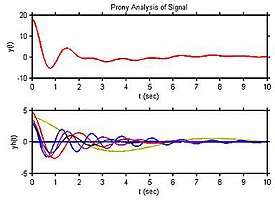Prony's method
Prony analysis (Prony's method) was developed by Gaspard Riche de Prony in 1795. However, practical use of the method awaited the digital computer.[1] Similar to the Fourier transform, Prony's method extracts valuable information from a uniformly sampled signal and builds a series of damped complex exponentials or damped sinusoids. This allows for the estimation of frequency, amplitude, phase and damping components of a signal.

The method
Let be a signal consisting of evenly spaced samples. Prony's method fits a function
to the observed . After some manipulation utilizing Euler's formula, the following result is obtained. This allows more direct computation of terms.
where:
- are the eigenvalues of the system,
- are the damping components,
- are the angular frequency components
- are the phase components,
- are the frequency components,
- are the amplitude components of the series, and
- is the imaginary unit ().
Representations
Prony's method is essentially a decomposition of a signal with complex exponentials via the following process:
Regularly sample so that the -th of samples may be written as
If happens to consist of damped sinusoids, then there will be pairs of complex exponentials such that
where
Because the summation of complex exponentials is the homogeneous solution to a linear difference equation, the following difference equation will exist:
The key to Prony's Method is that the coefficients in the difference equation are related to the following polynomial:
These facts lead to the following three steps to Prony's Method:
1) Construct and solve the matrix equation for the values:
Note that if , a generalized matrix inverse may be needed to find the values .
2) After finding the values find the roots (numerically if necessary) of the polynomial
The -th root of this polynomial will be equal to .
3) With the values the values are part of a system of linear equations that may be used to solve for the values:
where unique values are used. It is possible to use a generalized matrix inverse if more than samples are used.
Note that solving for will yield ambiguities, since only was solved for, and for an integer . This leads to the same Nyquist sampling criteria that discrete Fourier transforms are subject to:
Notes
- Hauer, J.F.; Demeure, C.J.; Scharf, L.L. (1990). "Initial results in Prony analysis of power system response signals". IEEE Transactions on Power Systems. 5: 80–89. doi:10.1109/59.49090. hdl:10217/753.
References
- Carriere, R.; Moses, R.L. (1992). "High resolution radar target modeling using a modified Prony estimator". IEEE Transactions on Antennas and Propagation. 40: 13–18. doi:10.1109/8.123348.
- Slyusar, V.I. (1998). "Interpretation of the Proni method for solving long-range problems" (PDF). Radioelectronics and Communications Systems. 41(1): 35–39.